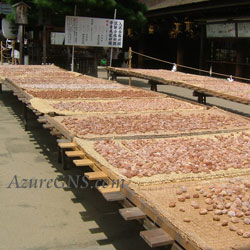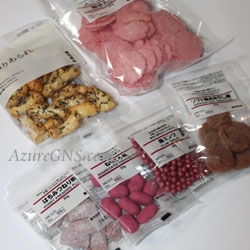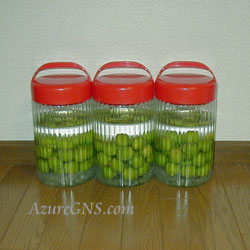(2月から3月)
Ume-matsuri;
The Japanese Apricot Festival
(from February to March)
●梅祭り Ume-matsuri; Ume Festival; Japanese apricot festival
●梅 (木)ume tree; Japanese apricot tree
(花)ume blossom; Japanese apricot blossom
●つぼみ bud
●つぼみが出る (to) bud; (to) put out buds; (to) shoot out buds
●咲く (to) bloom; (to) blossom; (to) be in bloom
●満開になる (to) be in full bloom
●花弁 petal
●一重 single
●八重 double
●ライトアップする (to) illuminate (ライトアップは和製英語)
●気象庁 the Meteorological Agency
●鶯 Japanese bush warbler
●梅酒 ume-shu; ume liquor; shochu flavored with ume and sugar candy
●梅干し umeboshi; a pickled (and dried) Japanese apricot
●赤紫蘇 red perilla leaf
●酸っぱい sour
◆梅には春告草という別名があり、日本人は梅が咲くと春の訪れを感じます。
Ume has another name; Haru-tsuge-gusa (the literally translation is a spring-telling grass) and Japanese people feel that spring is coming when they see ume blossoms in bloom.
◆梅は中国より日本へ伝わり、古来より日本人に愛され、桜と並び日本の代表的な花です。
Ume blossoms, a representative flower in Japan as well as cherry blossoms, was introduced from China to Japan, and Japanese people have loved ume since old times.
◆梅の花弁は一重か八重で、濃淡の白、赤、ピンク色です。
Petals of ume are single or double in various shades of white, red, or pink.
◆日本全国の天満宮には梅の木が植えられ、その多くで梅の花の開花時期に合わせて梅祭りが開催されています。
Ume trees are planted in the Temmangu Shrines throughout Japan, and Ume Festivals are held in most of them at blossoming time.
◆天満宮は菅原道真の霊を慰めるために創建されました。
The Temmangu Shrines were established for the consolation of Sugawara-no-Michizane’s spirit.
◆道真は優れた学者であり歌人であったので学問の神様としても信仰され、多くの受験生が天満宮へ合格祈願に訪れます。
As Michizane was a great scholar and a great poet of Waka (a Japanese traditional poetry composed in 5-7-5-7-7 syllables), he has been worshiped as a scholarly deity, so many examination candidates visit the Temmangu Shrine to pray for success.
◆当時の政府の高官であった道真は901年(延喜元年)に陰謀により都から大宰府へ左遷され、2年後悲憤のうちに最期を迎えます。
Michizane, a high official of the then government, was demoted from the capital to Dazaifu because of the intrigue in 901 (Engi 1st yr), and he passed away in indignation two years later.
◆梅を愛した道真は都を離れる前に庭の梅の木に、「東風(こち)吹かば匂ひをこせよ梅の花 主(あるじ)なしとて春な忘れそ」と短歌を詠みました。
He loved ume so much that he composed Waka for an ume tree in his garden before he left the capital;
“Kochi fukaba, nioi okoseyo, ume no hana, aruji nashitote, haruna wasureso”.
(My dear ume tree, bloom with a sweet smell when the wind blows from the east. Don’t forget to bloom in spring even if I leave you.)
◆その梅が道真を追い、一夜にして大宰府飛んで行ったという有名な飛梅伝説があります。
The famous “Tobi-ume-densetsu” (a legend of a flying-Japanese apricot tree) says that this ume flew to Dazaifu following Michizane in only one night.
◆1000年以上経った現在も飛梅は御神木として祀られ、毎春、美しい花を咲かせます。
Though more than 1000 years have passed since then, the Tobi-ume is worshiped as a sacred tree still now, and it blooms beautifully every spring.
◆太宰府天満宮を始め京都の北野天満宮、東京の湯島天神、山口の防府天満宮など菅原道真と縁がある神社の神文には梅紋が用いられています。
The crests of ume are used as heraldic symbols of the shrines, which are associated with Sugawara-no-Michizane, including Dazaifu Temmangu, Kitano Temmangu in Kyoto, Yushima Tenjin in Tokyo and Hofu Temmangu in Yamaguchi.
◆茨城県の水戸偕楽園には約110品種、3000本以上の梅が植えられています。
At Kairaku-en in Mito City of Ibaraki Prefecture, more than 3000 ume trees of about 110 varieties have been planted.
◆偕楽園は石川県金沢市の兼六園と岡山県岡山市の後楽園と並び、日本の三大名園の一つです。
Kairaku-en is one of the three great gardens of Japan along with Kenroku-en in Kanazawa City, Ishikawa Prefecture and Koraku-en in Okayama City, Okayama Prefecture.
◆1842年(天保13年)水戸藩第九代藩主徳川斉昭が民と共に楽しむために開園しました。
Nariaki Tokugawa, the ninth feudal lord of the Mito Clan, built Kairaku-en in order to enjoy this garden with common people in 1842 (Tempo 13th yr).
◆偕楽園には国内外から多くの観光客が訪れていますが、特に梅の季節にはとても混雑します。
Many tourists both from home and abroad visit Kairaku-en, and especially in ume blossom seasons Kairaku-en is very crowded.
◆偕楽園の梅まつりでは野点茶会、琴や尺八の演奏、梅娘や水戸黄門(水戸藩の第二代藩主)の一行との写真撮影会、梅の木のライトアップなどが多くの催しが行われます。
In the Ume Festival of Kairaku-en, many events are held such as an open-air tea ceremony, performance of Koto (a Japanese stringed musical instrument) and shakuhachi (a Japanese bamboo flute), photo sessions with Ume Girls and a company of Mito Komon (the second feudal lord of the Mito Clan), and illumination of ume trees.
◆梅は花を楽しむだけでなく、実を梅干し、梅酒、菓子などにします。
People use ume fruit for ume-boshi (ume fruit pickles with peculiar sour flavor), ume-shu (ume liqueur), and sweets as well as enjoying blossoms.
◆梅干しは一般的に熟した梅の実を赤紫蘇と共に約1ヶ月塩漬けにした後、3日間ほど日干しにして作ります。
A common recipe of ume-boshi is to pickle ripe ume fruit with salt and red perilla leaves for about 1 month and dry them for about 3 days.
◆梅干しは食用増進、疲労回復、解熱効果があり、古くから民間治療に用いられてきました。
Ume-boshi has been used in folk remedies for the improvement of appetite, recovery from fatigue, and effectively reducing fever.
◆おかゆと梅干しは腹痛や発熱した時の定番メニューです。
Rice porridge with ume-boshi is a typical remedy for a stomachache or high fever.
◆また抗菌や防腐のためにお弁当のご飯やおむすびにしばしば入れます。
Ume-boshi is often put into rice in a lunch box or a rice ball for antibacterial and preservative effects.
◆梅干し味のさまざまなお菓子も人気があります。
Various ume-flavored sweets and snacks are also popular.
◆梅酒は氷砂糖か黒砂糖を加えた焼酎に青梅を漬け込んだものです。
Ume-shu is liqueur made from preserving green ume fruit in shochu (Japanese distilled spirits) with rock candy or brown sugar.
◆また梅の実は漢方薬の材料にも使われます。
Moreover, fruits of ume are made into Chinese herbal medicine.
(より詳しい情報は「我が家の梅祭り」をご覧下さい。)
(Please see ”Our Japanese Apricot Festival Experience” for further information.)
Copyright (C) Azure Global Network Services. All Rights Reserved.











